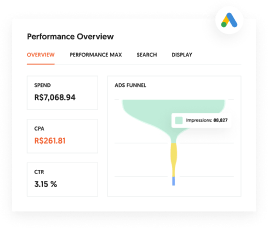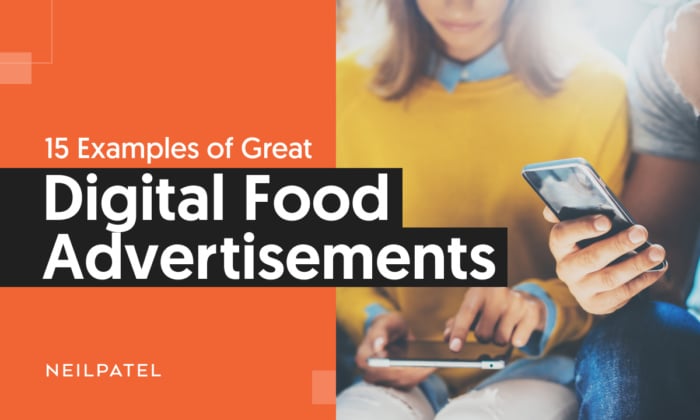
With over 31,000 food and beverage companies and one million restaurants operating in the U.S. alone, digital food advertisement is an incredibly competitive market.
To stand out, you need to combine humor, design, strategy, and user engagement, all while keeping your audience hungry.
Let’s take a look at what makes a digital food ad effective, and some of the names across the industry that are crushing it.
What Makes Food Advertisements Unique?
Without creative marketing campaigns, the food industry could be pretty dull. Luckily, there are so many ways to bring food to life in digital food advertisements.
What makes food advertisements unique is their ability to turn the mundane into excitement.
A simple burger on a plate can become a narrative story about your favorite sports game.
To create unbeatable food advertisements, you need to focus on high-quality ingredients.
Here are a few points to keep in mind that we’ll expand on later in the blog:
- Use visual storytelling
- Choose your colors carefully
- Show your brand’s voice and personality
- Research each platform for advertising
- Engage with your audience
- Stay ahead of trends
- Make your brand personal
- Tell your customers what to do next
Great Food Advertisement Examples
Great food advertisements should make your mouth water, your belly growl, and your heart warm.
Paired with intelligent marketing strategies, these food advertisements will help you create high-converting PPC campaigns that bring your brand to the global stage.
Here are some of our top picks for digital food advertisements.
1. Jif Peanut Butter
Leveraging motion graphics in your digital food advertisement is a great way to catch the eye of your scrolling audience.
In this Jif Peanut Butter ad, a beating heart communicates the excitement and love that the world has come to feel for Jif. Branded in the signature Jif colors, it also delivers clear brand awareness and integrity. This is a big brand marketing lesson in a jar!
2. Goldfish
Staying up to date on trends, holidays, and seasons is a great way to deliver relevant food advertisements to your audience.
Also, adjusting your PPC campaigns seasonally will help you create important audience connections and let your followers know you’re paying attention.
In this Twitter ad, @GoldfishSmiles used narrative video to tell a classic St. Patrick’s Day tale of two little fish who drank a bit too much.
This food advertisement is funny, creative, quirky, and relatable. Plus, it’s short and sweet, which makes it perfect for your Twitter feed.
3. Chipotle
Chipotle is a real success story. It’s innovative, accessible, and excels in digital sales. However, that’s not the only area where the California-based Mexican grill shines.
Chipotle is great at making adverts that get noticed. Let’s take its “Back to the Start” campaign as an example.
The animated ad debuted in U.S. movie theatres and at the Grammys. It’s a great example of visual storytelling. The ad highlights why we should consider looking towards a more sustainable approach to farming and food.

What makes the ad so great is it not only used visual storytelling to its maximum but also touched on a subject people care about, demonstrating an understanding of its audience and beyond.
Further, it showed the brand’s personality, and also gave Chipotle an excellent opportunity to display the brand’s ethics – a selling point that’s grown in importance to customers over the years.
Anyone can take the Chipotle approach in their food ads: use visual storytelling, engage an audience, and create a compelling narrative. Then ensure you put the ad on the right channels to get it noticed.
4. Clevr
Sometimes, all you need to create a high-quality food advertisement is a bit of color and simple movement.
In this Clevr food advertisement, the brand displays its Matcha Chai Latte and Chai Super Latte drinks.
Simple design, calming music, and pastel colors give the viewer a relaxing feel that evokes tranquility and calm.
Not only is the ad visually appealing, but it also offers diverse advertising usage. Clevr could easily use this food advertisement on a number of channels, from Twitter to Instagram and more.
5. Panera Bread
This Panera Bread Facebook ad leverages the thing we love most about food advertisements: the food!
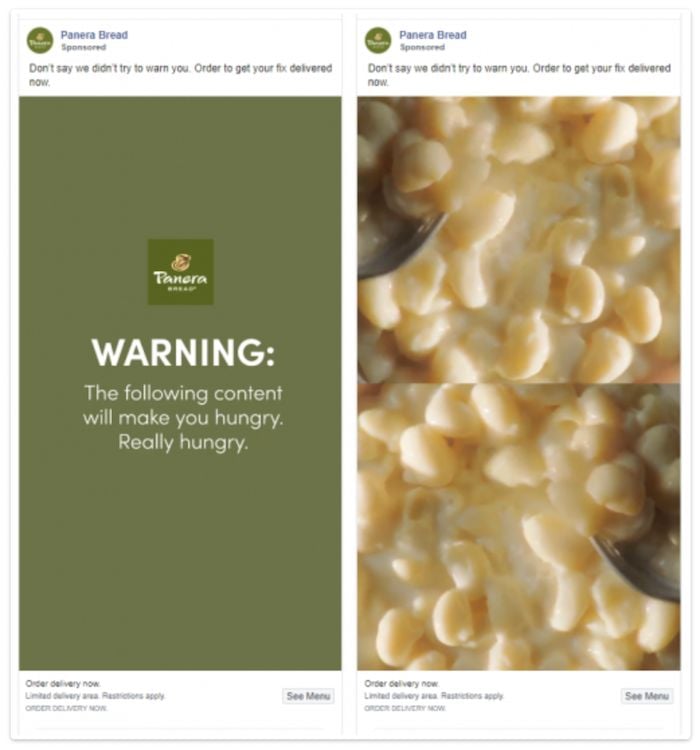
With an immediate appeal to our most natural human emotion (hunger), this food advertisement sets the stage for our cravings. From there, high-quality, macaroni-and-cheese imagery delights the senses.
It’s so delectable, you can almost taste it.
Another great thing about this food advertisement is that it uses a call-to-action at the end of the ad. In this way, Panera guides its audience directly to its desired end goal of purchasing some of its delicious macaroni.
6. Five Guys
Five Guys is one of those brands that always keeps it real. They do a few things really well, namely burgers, fries, and milkshakes.
With this kind of established brand identity, Five Guys can lean on the quality of their products more often.
In this ad, they are showcasing one of their best-loved products: the burger bun. The ad shows an image of the bun warming up, just waiting to be ordered.
They also use a creative call-to-action at the bottom, urging viewers to find their nearest Five Guys shop. This is a great tactic for brands that have a widespread presence and are looking to make sales in multiple locations.
Using a bit of humor, an appeal to emotion, and a simple yet effective image, this Instagram ad reminds customers that Five Guys knows what they’re good at, and they deliver it every time.
7. Burger King
Legacy fast-food chains have had to get creative in recent years in order to capture the hearts of Gen Z and millennial viewers.
Burger King knows these generations love nostalgia, and what better way to appeal to that emotion than by bringing back their legendary chicken fries?
In this Burger King Twitter ad, the brand relates its chicken fries to some of the most essential human traits. This appeal, although absurd, delivers the right dose of comedy to the ad.
In addition, the use of a custom graphic design is eye-catching and fun. The design ensures that any millennial scrolling down will stop and stare, remembering chicken fries from days past.
This campaign garnered features in HuffPost and Time magazine, alongside bringing 380 tweets per minute into the Burger King ecosystem.
8. IHOP
There’s no doubt about it, IHOP is an American classic. When it was time for the brand to celebrate 60 years of successful business, their marketing team wanted to do it in style.
This IHOP Twitter ad uses music, design, and graphics to thank its loyal customers for 60 years of continued service.
The creative copy of the post offers comedic relief, stating that the brand has been operating “for 60 pancakin’ years.”
Also, they further entice viewers by hinting at a surprise announcement only available on a certain date. This use of a deadline to encourage conversions is a great way to maintain audience engagement over time.
This food advertisement immediately piqued the attention of IHOP’s viewers, bringing in more than 43,000 retweets.
What was the big reveal? IHOP announced its new burgers by changing the company’s name (temporarily) to IHOb.
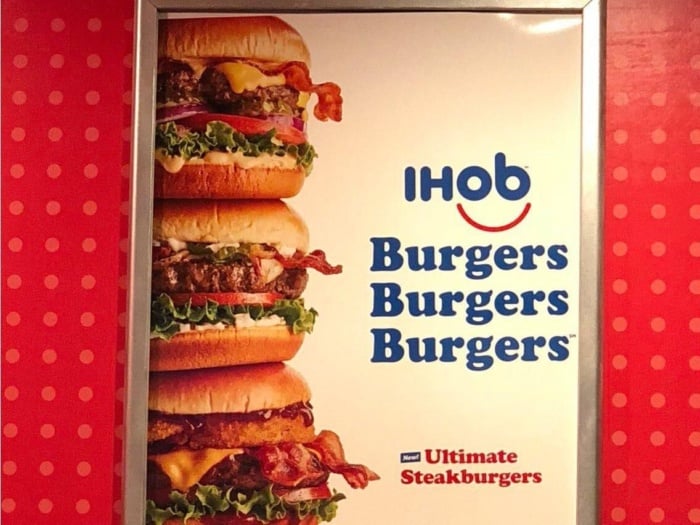
9. Taco Bell
Taco Bell has got social media advertising down to a fine art. When it’s not promoting its latest products to its near 10 million Facebook followers, it’s taking the educational approach.
Taco Bell uses its ads on Facebook to create a sense of urgency or excitement by announcing the return of old favorites or new store openings.
Then there’s the educational side. On Taco Bell’s Facebook page, you’ll see a series of videos that give viewers a glimpse behind the scenes.
In addition, Taco Bell increases engagement by giving a sneak peek at new locations or its Bell Hotel. It then enhances trust by explaining how they serve customers safely and promotes timely, seasonal offers to drive sales.
Finally, Taco Bell uses personalization, trends, and exclusivity in its advertising, as you’ll see below.
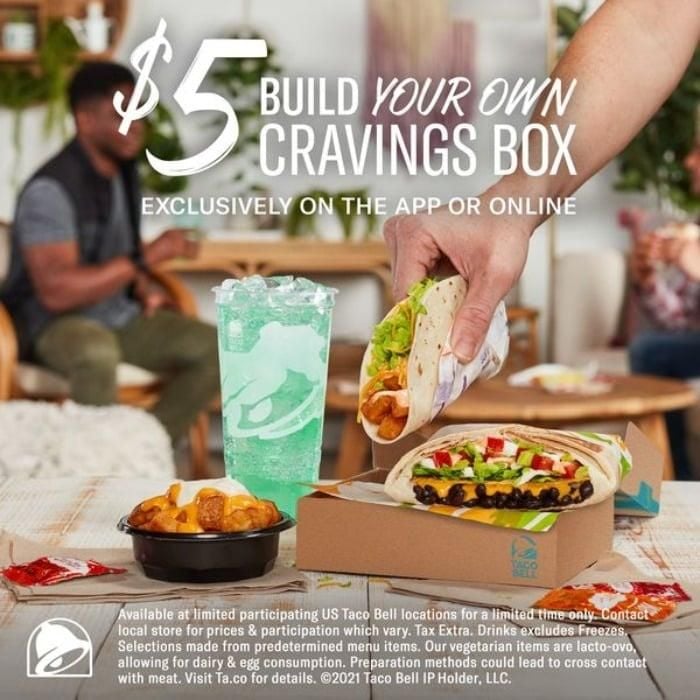
Taco Bell’s “Build Your Own Cravings Box” works on multiple levels:
- It appeals to people’s desire to personalize while highlighting affordability and limited availability.
- It also adds exclusivity by limiting its offer to online and app users, capturing the audience where they are at the time.
- With the imagery, you’ll see mouth-watering food and a leisurely image, cementing Taco Bell’s reputation as friendly and family-oriented.
In other words, Taco Bell says a lot without using complicated imagery or too much detail. This shows that sometimes the simplest ideas are best.
10. HelloFresh
User-generated content is a great asset to your marketing strategy.
In this HelloFresh story ad, a human voice is heard listing off the benefits of the meal-delivery service in an honest and human way.
The ad doesn’t use professional video production that you’d expect from a well-known company like HelloFresh. Instead, it showcases the perspective of a customer from her mobile phone, which adds to the honest nature of the post.
By using social proof, HelloFresh manages to show its audience that its product is legitimate and trustworthy.
11. Publix
One of the easiest ways to appeal to audience emotion is to connect your product to a well-loved pastime.
Publix knows America loves football. They also know no football game is complete without friends, drinks, and food.
This Publix Facebook Ad ran in the southern U.S. (the region where Publix operates) during football season. It targeted southern users who were known to enjoy football and were ages 21+.
If you were planning your weekend with a tailgate party and you saw this ad, it would immediately remind you to stock up on your favorite beer and snacks at your local Publix. This is emotional targeting at its finest.
12. Wendy’s
Another great paid advertising tactic is to offer a deal or use a coupon strategy.
In this Wendy’s Instagram ad, the brand uses a creative flatlay to promote their 4 for $4 summer deal.
This ad is effective because it creates a story for the viewer. Once you see this image, you can immediately picture yourself sitting poolside with a cheap meal, enjoying your best summertime life.
Wendy’s manages to promote their sale, appeal to emotion, and create a narrative, all with a few pieces of cardstock paper and a chicken burger. That’s impressive!
13. Dunkin’
When creating digital food advertisements, it’s important to leverage every tool available to you.
When you advertise using paid social, there are so many ways to get creative, encourage audience interaction, and show off your products at the same time.
Take this Dunkin’ food advertisement as an example. Dunkin’ is promoting its iconic donut fries.
To build hype around the release, they created an interactive Instagram story using the poll feature. This allowed their audience to vote on what they liked better: donuts or fries.
(Spoiler, the correct answer is donut fries).
While A/B testing these ads, Dunkin Donuts found that stories with a poll had a 20% lower cost per view than those without.
Not only was this a creative way to boost user engagement, but the brand gathered important data to inform their future campaigns.
14. M&M’S
Another way to engage an audience is to make your food ads fun, and this is something M&M’S achieves with ease.
M&M’S ads have been making us laugh for years, and some would say the brand exceeded expectations with one of its Super Bowl ads.
Taking its inspiration from modern life, the ad included everything from references to a “karen” and “mansplaining.” Dan Levy of “Schitt’s Creek” fame also put in an appearance.
Above all, though, the ad sought to make us feel more connected. Sarah Levy, Chief Marketing Officer at Mars Wrigley North America, explained the ad’s purpose was to: “Create better moments that make the world smile.”
If it’s in keeping with your brand, ask yourself how you can do the same.
15. Mochi Foods
Mochi Foods is a gluten-free Hawaiian food maker that creates pancake mixes, breads, waffles, and other offerings that use rice flour instead of wheat.
In this fun Mochi Foods social media ad, they show viewers what they can create with one pack of Mochi Food mix.
This ad is a great example of showcasing a product in action. Although a bag of Mochi Food mix might seem a bit boring, the product takes on new life once we see how it can be transformed into a delicious stack of fresh pancakes.
This ad can be used on a variety of platforms, which makes it diverse and multifaceted.
After watching it, you’re immediately hungry, which is the sign of an effective food advertisement.
8 Tips for Creating Effective Food Ads
Many of the best food ads use proven techniques to capture viewers’ attention, get people talking, and build customer trust. Regardless of your budget, these are all methods you can use in your food ad campaigns.
Let’s get started with the first one:
1. Use Visual Storytelling
Brands have used storytelling for decades. However, there’s now a greater emphasis on visual storytelling. Rather than relying on words, strong visual imagery enables food brands to gain viewers’ attention in a marketing world full of clutter and rivals’ messaging.
When a brand uses visual storytelling effectively, these food ads can encourage an audience to become regular customers.
However, what does visual storytelling mean?
You’ll find plenty of definitions online, but Shlomi Ron, CEO of the Visual Storytelling Institute, says it involves four main factors:
- creating compelling narratives
- ensuring the customer is the main focus of the story
- developing an emotional, visual media experience
- distributing these elements throughout the buyer’s journey
At a recent, Ron explained how visual storytelling would shape the future of advertising, citing brands like Panera Bread.
The Missouri-based company used its drivers in a campaign to improve consumer trust and credibility among shoppers. However, if you watch most of Panera Bread’s ads, you’ll notice visual storytelling is part of them.
How can you do the same? By:
- Determining the reaction you want from consumers: Do you want them to feel happy? Relaxed? Confident? How can your ad convey that?
- Learning from the best: There are plenty of good examples of visual storytelling around. Find a brand in your niche that does it well.
- Using tried and tested storytelling techniques: Hook your viewers from the first scene, show instead of telling, and create an effective narrative arc.
- Including customer stories: Make your ads customer-focused while addressing their concerns or wants.
Another way to do this is by demonstrating your values, showing your consumers what you care about, and how your brand makes the world a better place.
2. Choose Your Colors Carefully
Color is one of the most critical parts of your food ads. Picking the right color engages consumers and can affect their buying behaviors.
The right color also builds your food brand’s identity. In a sector where your branding needs to be bold to get noticed, it’s not surprising many food companies frequently use bright primary colors.
Food and drink brands often use reds, blues, oranges, and greens—and these colors all speak to shoppers differently.
For example, advertisers use red to trigger appetite, and consumers associate green with health. Yellow shades reportedly increase serotonin and happiness.
When choosing your colors, ask yourself, what emotions are you trying to express? How does your typical consumer think when they buy your product? How does your chosen color fit in with your brand overall?
3. Show Your Brand’s Voice and Personality
There’s a wide variety of personalities in food ads. You’ll see everything from playful and fun to formal and even functional. It all comes down to the overall tone of the individual brand.
However, whichever voice you’re going with needs to be powerful, and your buyers must recognize and relate to it.
Once you’ve decided on your brand’s personality, it’s best practice to incorporate it across your business, including your:
- Website
- Packaging
- Newsletters
- Logos
Take time to decide on your brand’s voice and ensure it’s consistent. Do you need inspiration? Take a look at Starbucks.
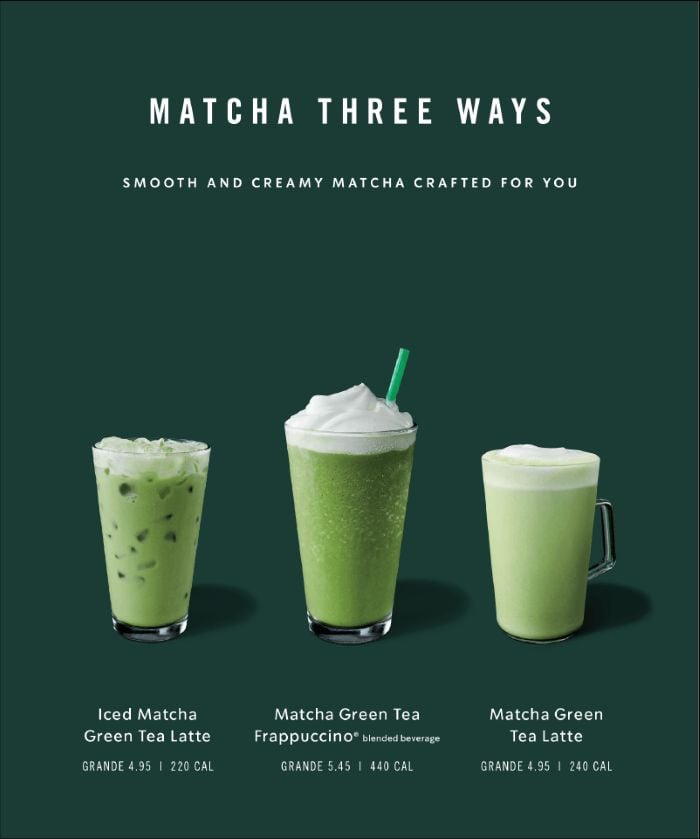
As the company explains, it’s gone with an expressive, functional voice, and it uses the same tone in-store, on social media, and its website. Starbucks incorporates the same styles of typography throughout too.
Take a note from Starbucks and create consistency throughout your food ads, right from the colors you use to the typography and tone.
4. Research Each Platform for Advertising
You could create the world’s best food ad, but if you’re putting it in front of the wrong audience, it’s going to be a waste of time and money.
There are many ways to get your brand noticed, but don’t feel like you have to be on every platform. The right vertical for you depends on who your market is and where you can find them.
If you’re using social media, then here are some key insights to know about each major platform:
- Facebook has enormous potential for restaurants.
- Twitter works best for sharing details of food industry happenings.
- Instagram and Pinterest work well for visual storytelling and sharing images.
- YouTube is the most obvious choice for sharing video guides.
- TikTok gives restaurants a chance to go viral and attract more customers.
Major food brands like Chipotle and Dunkin are using TikTok to promote new seasonal items and keep up with social trends.
It’s not all about social media, though. A lot of us consume information in different ways. Some prefer the website or blog format, while others like information presented in a newsletter or video adverts to watch on the go.
Make sure you understand your audience’s preferences so you can reach them and think of creative ways to captivate them.
5. Engage With Your Audience
While it won’t always be applicable, engaging with your audience is essential for brand building, and there are many ways you can do this.
Social media is open to everyone. It’s also one of the easier ways to engross your audience. You could do this by:
- sharing your food ads and inviting views
- asking followers to create user-generated content
- offering discounts and contests
Away from social media, you could include calls to action (CTAs), like the Starbucks Rewards program, website links, and sign-up forms to drive customers back to your site and nurture leads.
6. Keep Ahead of Trends
Knowing what’s hot is an effective way to boost your sales. One of the quickest ways of keeping up with new fashions is Google Trends.
You can use Google Trends for global searches or more localized regions, making it ideal for picking up on niche ideas for a specific area.
For instance, if you search for “food,” then “take out food” and “fast food restaurant near me” appear in the top five.
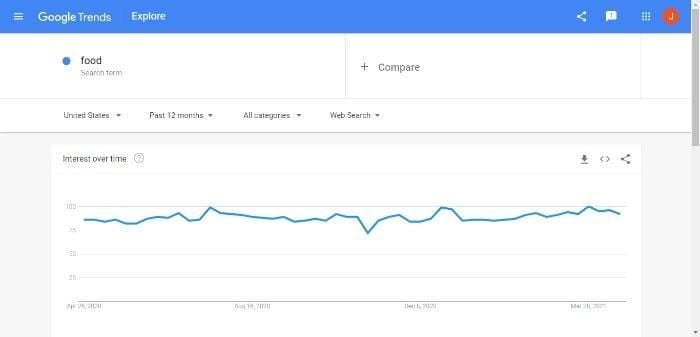
Niche it down further to “ice cream,” and you’ll get more specific search terms you could potentially work with.
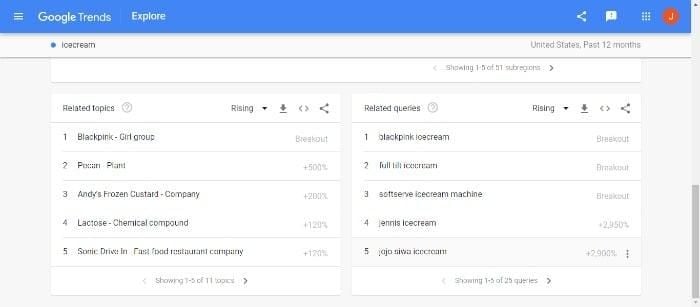
Other ways of identifying trends include Ubersuggest. There’s a free tool available, or you can sign up for the paid version for more features and a seven-day trial.
7. Make It Personal
Put a face to the name or tell the story behind the brand’s origins in your advertising. Amy’s Kitchen, for example, does this well.
You’ve only got to look at the story on the packaging to know Amy’s Kitchen is a family business that advocates organic, wholesome foods. If you go further and look at the website, you’ll see a group of happy employees. Additionally, you’ll learn that Amy’s supports local farmers and cares about quality.
As you can see, Amy’s advertising reflects its wholesome branding.
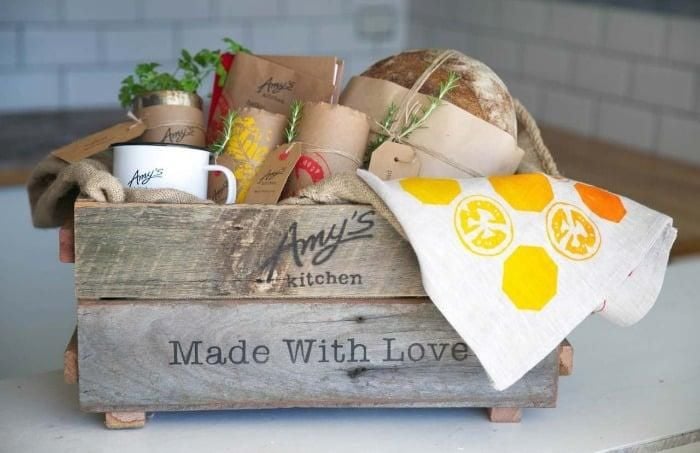
Amy’s Kitchen also supports its message about eating well and community through:
- newsletters and blog posts
- explaining its philosophy
- giving visitors a glimpse inside its business
These are all things your brand can learn from and incorporate into your food ads. What’s your unique story, and how can you use it in your branding? Can you:
- Tell the story of its origins?
- Feature your images?
- Include your name in the brand?
- Explain your company ethics?
Anything that differentiates your food ads will give you a better chance of getting noticed and set you apart from competitors.
8. Tell Your Customers What to Do Next
Your customers or potential buyers have finished reading your emails, looking at your newsletters, or visiting your social media pages.
What do you want them to do next, and how do you express this?
The usual technique is the CTA. For instance, if a would-be customer visits your website, where do you want them to go from there?
Do you want to encourage them to sign up for a newsletter or social media so they can learn more about your brand? Tell them, and maybe even offer an incentive!
FAQs
Stunning images are crucial to good food advertisements. Then, focus on what your consumers care about — are they health-conscious, worried about the environment, or do they prefer organic? Focus on what matters most to them.
Visual content is key in food advertising. Images of delicious food are the best way to sell food.
Social media and video are both idea platforms. Research where your audience spends time online and then focus on those platforms.
Paid ads on social media or Google Ads are a great way to broaden your reach and build brand awareness.
Conclusion
To create successful digital food advertisements, you need to come up with unique campaign ideas and maintain a cohesive brand image.
It’s also important to harness your social media marketing tactics across all channels, appeal to your audience’s emotions, leverage storytelling, and showcase your products in action are great ways to create food advertisements that stand out.
Because the food advertising market is so saturated, it may be hard to develop a paid ad strategy that actually gets you noticed.
If you’re struggling to create or find success with your paid ads, our agency is here to help!
What tactics do you use when creating great food advertisements?

See How My Agency Can Drive More Traffic to Your Website
- SEO - unlock more SEO traffic. See real results.
- Content Marketing - our team creates epic content that will get shared, get links, and attract traffic.
- Paid Media - effective paid strategies with clear ROI.
Are You Using Google Ads? Try Our FREE Ads Grader!
Stop wasting money and unlock the hidden potential of your advertising.
- Discover the power of intentional advertising.
- Reach your ideal target audience.
- Maximize ad spend efficiency.

